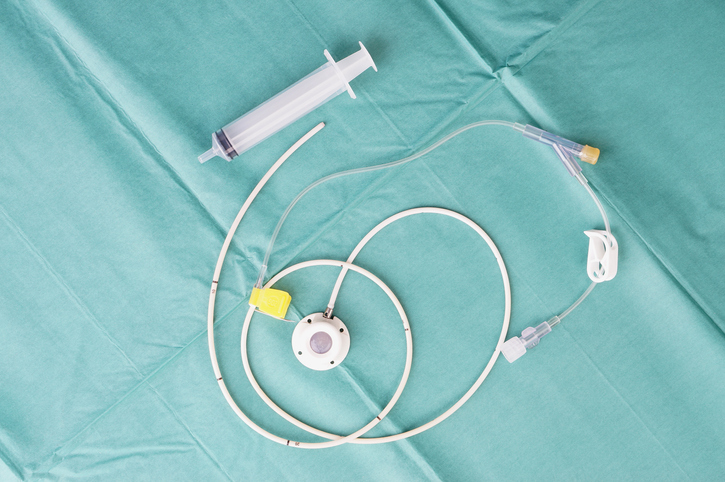Aug 07, 2023

As more patients are being treated at home and as an outpatient, the rise of insertion of totally implantable vascular access devices (TIVAD) increase. In this tidbit, we will look at what they are, why they are used and how to code the insertion of TIVADs.
What is a TIVAD?
TIVADs are a type of central venous catheter that are inserted into a large vein above the heart. These are placed in patients that will require frequent access to administer IV fluids, have frequent blood draws, parental nutrition, chemotherapy, or other substance. These are NOT pumps. These are inserted when the patient is expected to require treatment for a long period of time. TIVADs were originally invented for the comfort of patients and out of love for a patient that had many issues with damaged veins and required chemotherapy. These have been helping patients for 41 years, with the first one being inserted in 1982.
What are TIVADs used for?
The most common use of having a TIVAD placed is for chemotherapy. These are also placed in patients that require parenteral nutrition, fluids, antibiotics, frequent blood draws, blood transfusions, or other drugs.
How is insertion of a TIVAD coded in ICD-10-PCS?
Two codes are required for reporting a TIVAD. One for the tunneled catheter to the central vein and another for the insertion of the port. The catheter is tunneled under the skin with the catheter tip in a vein above the heart. The other end of this will connect to the port that is placed in the chest (routinely). This port is totally under the skin with no part being left outside of the body. The port is a small disc shaped implant that will be seen like a bump or lump under the skin at the insertion site.
What HIA is seeing is that only the tunneled part of the catheter is being coded with the implant/port ICD-10-PCS code left off. In some instances, this impacts the MS-DRG. On several of the cases that we have identified have both codes reported but the incorrect ICD-10-PCS code for the port is reported. The main thing to remember is that there are always two codes required and that the port must not be visible on the outside of the body and when a totally implantable port is inserted, it is coded as an open approach. Coders can look for terms like “pocket” and “port” in the operative note or radiology report. Other names that may be used for the TIVADs could be Port-a-Cath, Bardport, Infuse-a-Port, Medi-Port, Passport, and many others. If you are not familiar with terms used in the note you are viewing, these are easily found by searching Google.
An example of coding a TIVAD: Patient presented with uterine malignancy for insertion of TIVAD to assist in her long chemotherapy journey. Patient was taken to the radiology suite. Under fluoroscopy a puncture is made, and the catheter was tunneled through the subclavian vein and advanced in the superior vena cava. An incision in the chest was made to create a pocket for the port and the port was anchored in the pocket. The incision was closed in layers.
02HV33Z
Insertion of infusion device into superior vena cava, percutaneous approach is reported for the tunneled catheter into the superior vena cava.
0JH60XZ
Insertion of vascular access device into chest subcutaneous tissue and fascia, open approach is reported for the port placement in the chest.
Coders should review the entire operative note to ensure that all procedures are reported. Remember, coding changes are costly to the facility with the review and rebilling process. Best practice is to code it right from the start.
Be sure to subscribe to HIAlearn to take “Vascular Access Device Coding for ICD-10-PCS” and other coding courses.
References
https://www.hey.nhs.uk/patient-leaflet/totally-implantable-venous-access-devices-tivad-port-a-cath
https://www.cancer.gov/publications/dictionaries/cancer-terms/def/port-a-cath https://www.ncbi.nlm.nih.gov/pmc/articles/PMC2727812
Coding Clinic, Fourth Quarter 2017 Pages: 62-64
Coding Clinic, Fourth Quarter 2015 Pages: 26-28
Coding Clinic, Second Quarter 2015 Pages: 33-34
Coding Clinic, Second Quarter 2017 Pages: 24-26
Coding Clinic, Second Quarter 2016 Page: 14
Coding Clinic, First Quarter 1996 Pages: 3-4 (for explanation of TIVAS)
Since 1992, HIA has been the leading provider of compliance audits, coding support services and clinical documentation audit services for hospitals, ambulatory surgery centers, physician groups and other healthcare entities. HIA offers PRN support as well as total outsource support.
The information contained in this coding advice is valid at the time of posting. Viewers are encouraged to research subsequent official guidance in the areas associated with the topic as they can change rapidly.
Subscribe to our Newsletter
Recent Blogs
Related blogs from Industry News , Medical Coding Tips
Interventions for endovascular revascularizat...
The 2026 updates to CPT and the Hospital Outp...
Accurate diagnosis coding relies on recognizi...
Halloween brings fun, fright—and a rise in em...
Subscribe
to our Newsletter
Weekly medical coding tips and coding education delivered directly to your inbox.




